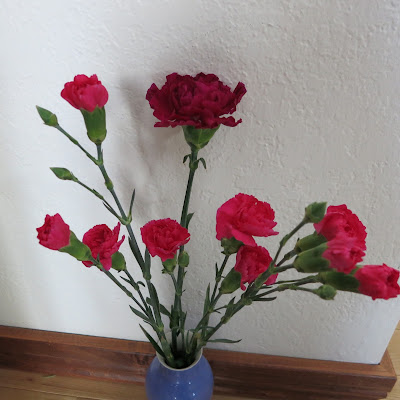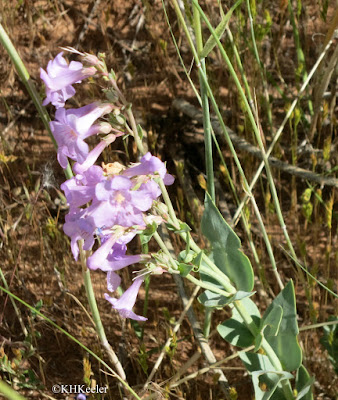The garden store was robbed: it was a violet crime.
 |
| sweet violet, Viola odorata |
 |
| carnations, Dianthus caryophyllus |
Other common garden plants were grown across the world and brought to Europe between the 1500s and the 1800s and taken from there to North America (and Canada, Australia, New Zealand...), for example chrysanthemums (Chrysanthemum species) from China, nasturtiums (Tropaeolum majus and relatives) from South America.
 |
| nasturtium Tropaeolum sp. |
 |
| green-flowered cactus, Echinocereus viridiflorus native from South Dakota and Wyoming to New Mexico and Texas |
There are many reasons for this, but NOT that there ae no handsome native wildflowers.
 |
| blanket flower, Gaillardia, native wildflower |
 |
| pasqueflower, Anemone patens, native wildflower |
Why?
One explanation is time and space: too few years and too few plant people in the region. Lots that could be done hasn't been because there hasn't yet been time and resources.
But just seeing a pretty plant doesn't put it in the garden shop:
Some wildflowers have characteristics that makes them bad garden plants. Perhaps they don't flower every year or only for three days or get too tall and fall over. Or get a leaf fungus and turn musty gray. Multiple attempts to turn them into garden flowers may have failed.
Alternatively, the plants might be difficult to propagate. What if they have a deep tap root so they mostly die when transplanted, don't spread so there's no easy vegetative propagation and the seeds ripen and fall to the ground individually, so that to gather seeds you have to go back every day? It will be very difficult to get enough of a plant like this to be able to sell it to seed companies or nurseries.
The long-time cultivated garden species have had these problems worked out.
I advocate growing locally-native plants in your garden, but I'm writing this to explain why that is not necessarily easy.
In addition to not finding the plants for sale, it is not necessarily easy to grow them:
Not Necessarily Easy 1) In the arid and semi-arid west, gardens are usually provided with supplemental water. Locally native plants are adapted to the low natural rainfall. If you add water, they can become annoyingly aggressive: overrunning other flowers, spreading into neighboring flowerbeds, coming up as seedlings in your paths and lawn. It requires self-discipline as a gardener to keep them a little thirsty and under-fertilized. But that is what "locally native" means: self-perpetuating in this climate without any human help.
 |
| Oenothera suffrutescens, waving butterfly, native in the plains, a weed in California |
Not Necessarily Easy 2) People love diversity and novelty. Garden stores know it. So lots of the plants offered are from elsewhere: slightly north, slightly south, slightly east or west, or from across the world where the climate is "similar enough."
In a garden store, it is usually hard to know what is native to your area. For example, "native wildflower seed" often means "native to North America", with seeds of easy-to-grow plants native to California, Colorado, Wisconsin, Texas, Massachusetts and Virginia all in the mix. Very few plants are native all across North America: in most cases, closely related species replace each other as you travel. Sometimes a pair of species cover most of the distance: common milkweed (Asclepias syriaca) is native from the Atlantic Coast to central Nebraska, the showy milkweed (Asclepias speciosa) from western Nebraska west to the Pacific Coast. One or the other is native locally, but not both. Now look at all the less common species of milkweed on the USDA plants website and notice that none of them is continent-wide link. (Hit the Show All tab in the upper right and scroll down). Or see the columbines (Aquilegia, the one mapped in blue is from Europe: link - hit Show All in the upper right, scroll down).
To find local wildflowers you can take a list of native wildflowers (for example, from the guide to a nearby park or natural area) to the nursery and try to pick out plants on the list, but often the tag doesn't give you a species name, just "Penstemon Summer Sky." Okay, it is a Penstemon, beardtongue, but there are 236 species listed as native to the United States on the USDA plants database (link, again, hit Show All in the upper right corner and scroll down). That's perhaps an extreme case, but penstemons are popular garden plants, at least some of them.
 |
| one-sided beardtongue, Penstemon unilateralis |
Not Necessarily Easy 3) One reason given for growing locally native plants is to support local animals, especially insects. When those are small bees, it is easy: you get to see shiny green bees, for example, on your flowers. But some of the local native pollinators are moths and butterflies whose caterpillars eat plants. When people promote milkweeds for monarchs, they mean the monarch female will lay her eggs on the milkweed and the resulting caterpillars will gorge themselves eating the milkweed. That is, making holes in the leaves, ever larger as the caterpillars grow. If you are a success, you get lots of caterpillars and plants that look terrible, their leaves reduced to shreds.
That applies to growing other natives: their natural insect enemies may find them and quite naturally, eat them. You have to notice glorious little-seen butterflies flying in your yard to appreciate the result of having your plants nibbled to the ground.
Not Necessarily Easy 4) Seed and plant availability for local wildflowers can be quite variable. We're used to getting all of anything we want, but for local wildflowers that isn't always possible. A few energetic seed companies raise the plants and gather seeds and also create small plants for nurseries, but some years the yield is poor or the demand is surprising, and the seeds run out. When they do, there's no magic wand: it'll be at the end of next growing season before there are more. (If that happens, find people in your area who grow local plants and trade plants.)
 |
| Rocky Mountain geranium, Geranium caespitosum I could only find one seed company is selling it this year |
 |
| A native Rocky Mountain foothills violet, Viola nuttallii It is not available commercially (as far as I can tell). |
The pasque flower shown is the European species (Anemone/Pulsatilla vulgaris). Anemone patens has that are less elongate and more sparsely dissected. Also, it's leaves typically don't emerge until the flowers are finished, though the bracts below each flower are leaf-like.
ReplyDeleteThank you! I've grown that particular plant for decades and never keyed it.
Delete